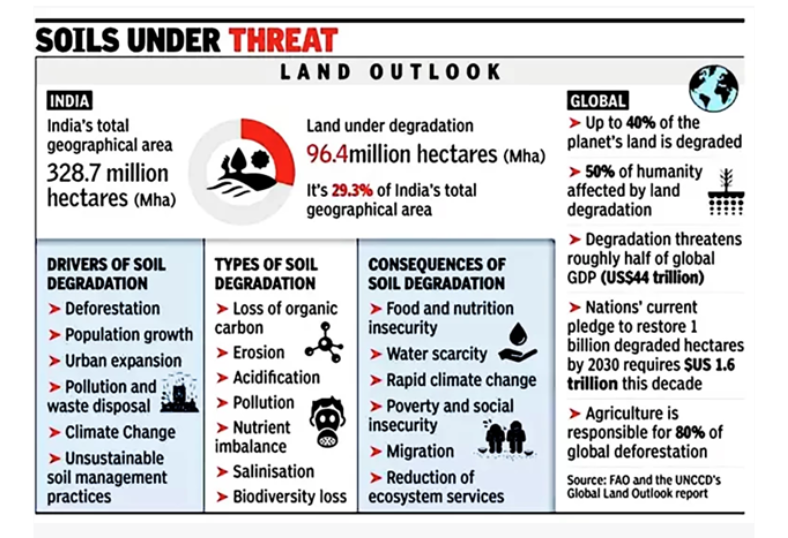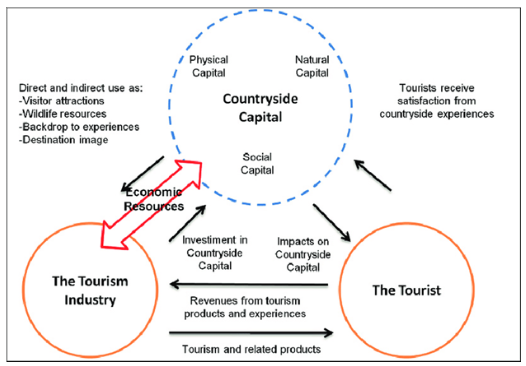10 Nov to 24 Nov, 2023
GLOBAL NATURAL DISASTER ASSESSMENT
Why in news : Recently a Global Natural Disaster Assessment report was published showing that the overall economic losses from natural disasters were relatively large, but the number of deaths and affected people remained low.
About :
- Global natural disasters, like hurricanes, earthquakes, floods, and wildfires, are on the rise. The 2022 Global Assessment Report on Disaster reveals an 83% increase in climate-related events, exemplified by the Amazon Rainforest Fires and Hurricane Katrina in 2005. These disasters underscore escalating environmental and socio-economic risks, emphasizing the urgency for comprehensive mitigation and adaptation strategies.
|
Category |
Type |
Example |
Fact/Evidence |
|
Climatic Disasters |
Hurricanes and Typhoons |
Hurricane Katrina (2005) |
Increasing intensity linked to warming sea surface temps. |
|
Floods |
2022 Pakistan Floods |
Floods affect more people globally than any other disaster. |
|
|
Droughts |
California Drought (2012-2017) |
Linked to climate change, causing water scarcity. |
|
|
Geological Disasters |
Earthquakes |
Haiti Earthquake (2010) |
Seismic activity along tectonic plate boundaries. |
|
|
Tsunamis |
Indian Ocean Tsunami (2004) |
Triggered by underwater earthquakes, causing coastal damage. |
|
Wildfires |
Forest Fires |
Australian Bushfires (2019-2020) |
Longer, more intense fire seasons due to climate change. |
|
Environmental & Technological Disasters |
Nuclear Accidents |
Fukushima Daiichi (2011) |
Environmental impact extends beyond immediate vicinity. |
|
|
Industrial Accidents |
Bhopal Gas Tragedy (1984) |
Human and environmental consequences of chemical disasters. |
ENVIRONMENT AND GEOGRAPHICAL VULNERABILITY TO NATURAL DISASTERS
- Rising Sea Levels: The Intergovernmental Panel on Climate Change (IPCC) reports a global sea level rise of 3.3 mm per year. Eg. Small island nations like Tuvalu face heightened risks of flooding and salinity intrusion.
- Deforestation and Landslides: The World Bank estimates that 17% of the Amazon Rainforest has been lost in the last 50 years. Eg.The 2022 landslide in Joshimath was exacerbated by deforestation, resulting in tragic consequences.
- Tectonic Activity and Earthquakes: Areas located along tectonic plate boundaries are at higher risk of earthquakes. The "Ring of Fire" around the Pacific Ocean is a seismic hotspot with frequent earthquake activity. Eg. The 2011 earthquake in Japan, situated on the Pacific Ring of Fire, caused a devastating tsunami and nuclear disaster.
- Climate Change and Extreme Weather Events:The National Oceanic and Atmospheric Administration (NOAA) notes an increase in the number of extreme weather events globally.
- Eg: The 2019-2020 Australian bushfires, exacerbated by prolonged heatwaves, showcased the link between climate change and extreme events.
DIRECT AND INDIRECT IMPACT ON BIODIVERSITY
Direct Impact
- Loss of Habitats : Amazon rainforest fires have devastated the habitats , resulting in loss of numerous plants and animal species , especially endemic flora and fauna in regions.
- Coral bleaching : Rising sea temperatures, linked to climate change, cause coral bleaching in the Great Barrier Reef.
- Threat to ecosystem resilience : Soil liquefaction and coastal subsidence disrupted habitats, leading to the loss of biodiversity and threatening ecosystem resilience.
- Mangrove Systems : 2004 Indian Ocean Tsunami highlighted the extensive damage to mangrove forests, seagrass beds, and coral reefs.
Indirect Impact
- Nuclear Disaster : Radioactive contamination from the Fukushima nuclear meltdown affected soil, water sources, and marine sediments, influencing the health of terrestrial and aquatic organisms.
- Glacier Lake Outburst floods : Melting glaciers contribute to the formation of glacial lakes, can lead to sedimentation, altering river courses and affecting aquatic habitats downstream.
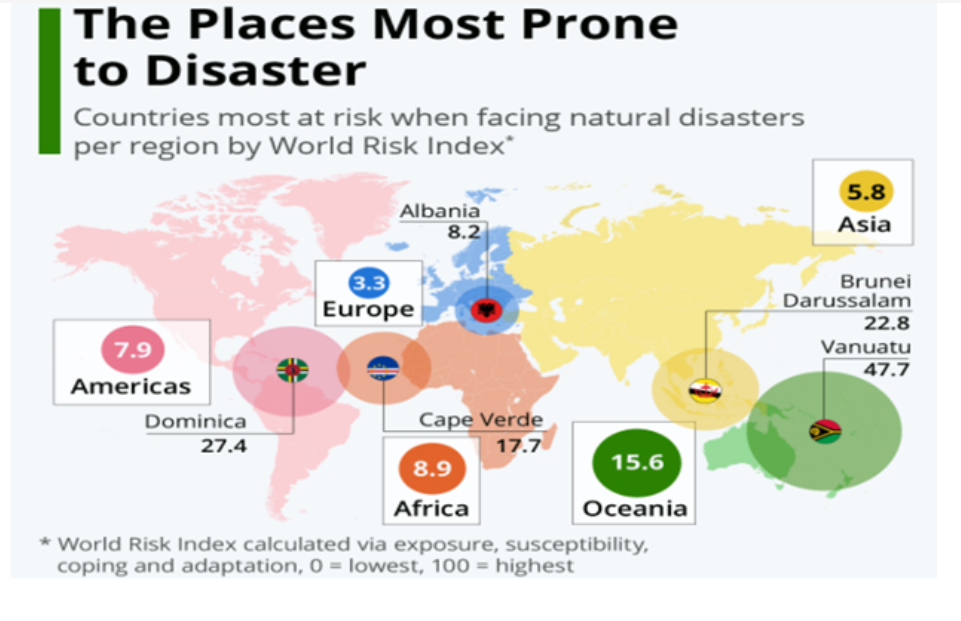
SOCIO ECONOMIC IMPACTS OF NATURAL DISASTERS ON VULNERABLE COMMUNITIES
- Disproportionate Economic Loss: The World Bank notes that low-income countries suffer a disproportionate economic burden, with losses reaching up to several percentage points of their GDP. Example: The 2010 Haiti earthquake resulted in economic losses equivalent to 120% of the country's GDP, severely impacting an already impoverished population.
- Housing Vulnerability and Displacement: The International Organization for Migration (IOM) reports that natural disasters displace an average of 26 million people annually, with vulnerable populations being the most affected.
Eg: The 2013 Typhoon Haiyan in the Philippines led to the displacement of over four million people, predominantly from low-income coastal communities.
- Impact on Livelihoods and Agriculture: The Food and Agriculture Organization (FAO) estimates that 22% of the total economic impact of natural disasters is absorbed by the agricultural sector. Eg: The 2015 earthquake in Nepal severely impacted rural communities, causing extensive damage to crops and livestock and jeopardizing food security.
- Health and Education Challenges: UNICEF reports that natural disasters often result in the breakdown of essential services, leading to increased mortality rates and hindering access to education. Eg: The 2004 Indian Ocean Tsunami disrupted health services and education in affected regions, exacerbating vulnerabilities in already marginalized communities.
- Long-term Poverty Traps: The socio-economic impacts of natural disasters can create long-term poverty traps for vulnerable communities. Eg. Research published in the World Development journal suggests that the economic recovery of vulnerable communities can take years or even decades.
|
CASE STUDY : JOSHIMATH LAND SUBSIDENCE IN UTTARAKHAND Joshimath, located in Seismic Zone V is prone to earthquakes , gradual weathering and water percolation. However subsidence might have been triggered by the reactivation of a geographic fault where the Indian Plate has pushed under the Eurasian Plate along the Himalayas. Anthropogenic factors like Tapovan Vishnugad Hydropower , widening of Char Dham Project , rampant tourism , unplanned urbanization , water withdrawals and absence of proper drainage have contributed to disaster in 2022. |
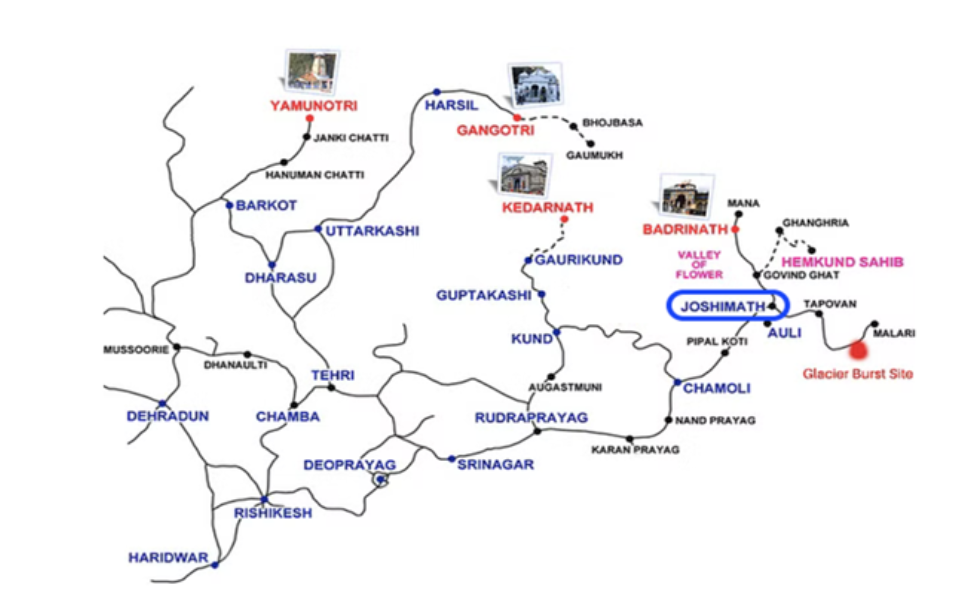
CHALLENGES IN REBUILDING AND SUSTAINABLE DEVELOPMENT POST NATURAL DISASTERS IN INDIA
- Infrastructure Deficiencies: The National Disaster Management Authority (NDMA) reports that inadequate infrastructure hampers rapid response and recovery efforts.Eg : Cyclone Fani in 2019 exposed vulnerabilities in the infrastructure of coastal areas in Odisha, hindering swift recovery.
- Urban Planning and Informal Settlements: Rapid urbanization and informal settlements in India contribute to challenges in post-disaster rebuilding.Eg.The 2023 Nepal earthquake highlighted issues in urban planning, with informal settlements facing severe damage and slow reconstruction.
- Population Density and Resettlement: High population density complicates resettlement efforts post-disaster. Eg : The 2013 Uttarakhand floods led to challenges in relocating affected populations due to limited available land and resources.
- Environmental Degradation and Climate Change: The Ministry of Environment, Forest and Climate Change (MoEFCC) recognizes the impact of climate change on the frequency of extreme weather events. Example: The recurring floods in Assam showcase the compounding challenges of rebuilding in the face of changing climate patterns.
- Coordination and Governance: Poor coordination between the state government, military, and disaster response agencies led to delays in reaching affected areas and providing essential aid. Eg. Bengaluru floods
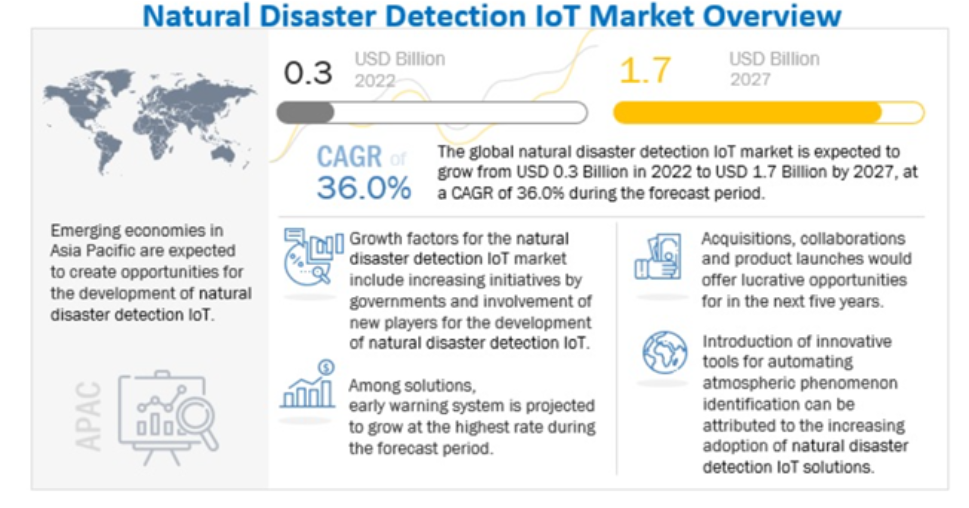
GLOBAL INITIATIVES FOR DISASTER MITIGATION
- Sendai Framework : It is the successor instrument to the Hyogo Framework for Action (HFA). It aims to guide the multi hazard management of disaster risk in development at all levels as well as within and across all sectors.
- The Climate Risk and Early Warning Systems (CREWS): The Climate Risk and Early Warning Systems (CREWS) is an initiative to saves lives, assets and livelihoods through increased access to early weather warnings and risk information for people in Least Developed Countries (LDCs) and Small Island Developing States (SIDS).
- Green Climate Fund : It provides an overview of country needs and evidence-based programming experiences in the relevant sector.
INDIA INITIATIVES
- Coalition for Disaster Resilient Infrastructure Society (CDRIS): It aims to increase the resilience of infrastructure systems to climate and disaster risks, thereby ensuring sustainable development.
- National Disaster Management Plan (NDMP): It lays down policies, plans and guidelines for Disaster Management to ensure timely and effective response to disasters.
CONCLUSION
India faces a complex web of challenges in the aftermath of natural disasters, exacerbated by infrastructure deficiencies, urban planning issues, and the impact of climate change. The variety of disasters highlights the intersection of natural and anthropogenic factors. While global initiatives like the Sendai Framework and the Climate Risk and Early Warning Systems provide a broader framework for disaster mitigation, India's National Disaster Management Plan and the Coalition for Disaster Resilient Infrastructure Society are crucial domestic steps toward enhancing resilience. Sustainable development hinges on coordinated efforts, innovative strategies, and a proactive approach to mitigate the socio-economic and environmental impacts of natural disasters in India.
Where to use ?
Paper II ( Geography optional ) : Contemporary issues , Climate change and disasters
Paper III ( General Studies ) : Disaster Management
Source :
https://www.preventionweb.net/publication/2022-global-natural-disaster-assessment-report
GLOBAL TIGER NUMBERS ARE RISING
Why in news : Countries have submitted tiger population numbers from 2010-2022 to the Global Tiger Recovery Program (GTRP) and United Nations Convention on International Trade in Endangered Species (CITES) under GTRP 2.0 which aims to pave the way for tiger conservation from 2023-2034.
About :
KEY FINDINGS
- Wild tiger status is good in South Asia and Russia, but the picture in Southeast Asia is grim
- There has been an overall increase in the tiger population by 60 per cent, taking the number to 5,870.
- Countries like Bhutan, Myanmar, Cambodia, Lao-PDR and Vietnam showed decline in tiger populations, making the situation “grim” in the Tiger Range Countries (TRCs) of Southeast Asia.
- Success of countries in South Asia like Bangladesh, Bhutan, India and Nepal including China and Russia in North East Asia is attributed to effective measures taken for habitat conservation and protection.
- Nepal has tripled the tiger population.
CAUSE FOR DECLINE IN NUMBER OF TIGERS
- Invasive Species: Proliferation of invasive species like Lantana camara in Indian forests has led to habitat degradation, reducing the abundance of ungulates that tigers depend on for sustenance.
- Man-Animal Conflict: Sundarbans in West Bengal witness frequent man-tiger conflicts due to the close proximity of human settlements to tiger habitats, resulting in fatalities on both sides.
- Infrastructure Development: The expansion of highways through wildlife corridors in central India, like the Pench-Kanha corridor, disrupts tiger migration routes, isolating populations and hindering genetic diversity.
- Disease: Outbreak of Canine distemper virus in the Sariska Tiger Reserve in Rajasthan led to the death of several tigers, highlighting the vulnerability of these apex predators to diseases.
- Poaching: The arrest of poachers in the Simlipal Tiger Reserve in Odisha in 2020, with seized tiger bones and skins, underscores the persistent menace of poaching even in well-protected reserves.
- Insufficient Prey: Some tiger reserves suffer from an inadequate prey base, jeopardizing the sustainability of tiger populations. Example: The Palamau Tiger Reserve in Jharkhand faces a challenge in maintaining viable tiger populations due to a decline in prey species, emphasizing the need for ecological balance in protected areas.

GLOBAL INITIATIVES
- ST. PETERSBURG DECLARATION ( 2010 ) : It brought together world leaders to endorse the Global Tiger Recovery Program (GTRP), which aimed to double tiger populations by 2022.
- GLOBAL TIGER INITIATIVE ( 2008 ) : It fostered collaboration among governments, NGOs, and international organizations to support tiger conservation efforts.
- CONVENTION ON INTERNATIONAL TRADE IN ENDANGERED SPECIES ( CITES ): CITES regulates the trade of tiger parts and products, aiming to eliminate illegal wildlife trade and ensure the legal and sustainable sourcing of tiger specimens.
INDIAN INITIATIVES
- Project Tiger
- National Tiger Conservation Authority
- Tiger Census in India
- Wild Life (Protection) Amendment Act, 2022
CONCLUSION
While the global rise in tiger populations is encouraging, the pressing issues confronting Southeast Asian tigers necessitate urgent attention and thorough conservation measures. The coordinated endeavors of nations, underpinned by impactful policies and consistent resources, are crucial to guarantee the ongoing resurgence and welfare of this iconic species.
Where to use ?
Paper I ( Geography optional ) : Wildlife Conservation
Paper III ( General Studies ) : Conservation
Source:
THOUSANDS OF EARTHQUAKE ROCK ICELAND
Why in news : Recently , Iceland has declared a state of emergency following a series of 800 earthquakes that struck the southwestern Reykjanes peninsula in less than 14 hours.
About :
- Around 1,400 earthquakes occurred in 24 hours and 24,000 have been recorded in the Reykjanes peninsula since late October.
- The most powerful of these quakes had a magnitude of 5.2, and hit about 40 km from Reykjavík, Iceland’s capital.

WHAT IS HAPPENING TO ICELAND ?
- Iceland is located on the Mid-Atlantic Ridge, technically the longest mountain range in the world, but on the floor of the Atlantic Ocean.
- The ridge separates the Eurasian and North American tectonic plates — making it a hotbed of seismic activity.
HOW CAN EARTHQUAKE SWARMS BE PORTENTS FOR VOLCANIC ACTIVITY ?
- Formation of Magma: Deep beneath the Earth's surface, the intense heat initiates the process of rock melting, giving rise to magma. This viscous, flowing substance is lighter than solid rock, setting the stage for geological activity.
- Magma Chambers and Underground Trapping: The upward movement of magma leads to its accumulation in underground chambers. These reservoirs, situated deep within the Earth, act as storage for the molten substance, creating a dynamic geological environment.
- Volcanic Eruptions: While most magma remains trapped, a fraction finds its way to the surface through vents and fissures, resulting in volcanic eruptions. This explosive release of magma has significant geological consequences and is a key driver of Earth's dynamic landscape.
- Earthquake Swarms: The movement of magma in proximity to the Earth's surface exerts force on surrounding rocks, often triggering earthquake swarms. These seismic events are symptomatic of the geological activity occurring beneath the Earth's crust.
- Surface Proximity and Eruption Likelihood: As magma moves closer to the Earth's surface, the likelihood of an eruption increases. The proximity to the surface is a critical factor influencing the eruption potential, with the escalating risk often accompanied by more frequent earthquake swarms.

HOW MANY ACTIVE VOLCANOES DOES ICELAND CURRENTLY HAVE ?
- Iceland has 33 active volcanoes which have erupted over 180 times in the past 1,000 years.
- One of Iceland’s most famous volcanoes is Eyjafjallajökull.
- Other famous volcanoes include Hekla, Grímsvötn, Hóluhraun, and Litli-Hrútur (part of the Fagradalsfjall system).
Where to use :
Paper I ( Geography optional ) : Volcanoes and Earthquakes
Paper III ( General Studies ) : Disasters
Marine Cloud Brightening - Edukemy Current Affairs
Marine Cloud Brightening : Marine cloud brightening refers to an albedo modification technique that aims to increase the reflectivity, and possibly even the lifetimes, of certain clouds in order to reflect more sunlight back into space and partially offset some of the impacts of climate change. The most common proposal for achieving such a goal is to inject naturally occurring sea salt into cloud updrafts.
Land Degradation neutrality
Land Degradation neutrality: It is the state in which value of land providing economic and ecosystem services remains constant or increases over a period of time. It aims at prevention of degradation through preventive and curative measures.
Fulgurites
Fulgurites: Fulgurites are hollow glass tubes that form when lightning strikes the ground. They are also known as "fossilized lightning".Its formation is caused by extreme temperatures of more than 1,710 degrees Celsius.
Biomimicry
Biomimicry : Bio' means living organism; 'mimicry' means to imitate. Biomimicry is thus the practice of imitating life and nature. Its aim is to draw inspiration from nature's engineering in order to solve the world's most pressing challenges and ensure a sustainable future for all life on earth.
Annual Solar Savings
Annual Solar Savings : Annual solar savings is the amount of energy saved each year from solar technology. It's calculated by subtracting the amount paid for solar from what would have been paid for electricity. This includes tax incentives.
Place in news
1. Umiam Lake
- Why in news : Meghalaya government has decided to use AI-Powered boat to clean Umiam Lake
- Umiam Lake, also known as Barapani Lake, is a lake in the state of Meghalaya 15 km (9.3 miles) north of Shillong, the capital of Meghalaya.
- It is encircled by lush green East Khasi hills.
- It is one of the biggest artificial lakes in Meghalaya, spread over an area of 10 square km,
- The confluence of the two streams, Umkhrah and Umshvrpi, form the Wah Ro-ro stream in the northwest of the town and joins River Umiam, the main source of water for the lake.
- Approx: Shillong
2. Anantapur
- Why in news : Recently, rains spur farm activity in Anantapur.
- Anantapur, officially Anantapuramu, is a city in Anantapur district of the Indian state of Andhra Pradesh.
- It has a semi-arid climate, with hot and dry conditions for most of the year. It is part of Rayalaseema region on the state.
- Gooty Fort is a historical fort on a hill dating to the 11th century.
- Approx. Kurnool
3. Kibithu
- Why in news : Recently, the military camp at Kibithu has been renamed after former CDS Bipin Rawat
- It is a small village in Arunachal Pradesh’s Anjaw district, and located on the last road head of extreme northeast of north eastern India and the very place where the Lohit River enters India.
- It is one of the places which forms the Indo-China border and has always been a place of great importance. It is uniquely located on the trijunction, with China to the north and Myanmar to the east.
- Approx : Anjaw
4. Talakayala Betta
- Why in news : Recently, the Zika virus was found in mosquitoes in Talakayalabetta village
- It is located in Sidlaghatta taluka of Chikkaballapura district in Karnataka, India.
- Recently, the Zika virus was found in mosquitoes in Talakayalabetta village.
- Approx: Chikkaballapura
5. Kozhikode
- Why in news : Recently all schools, colleges in Kozhikode remained closed due to Nipah Virus outbreak.
- It is a city along the Malabar Coast in the state of Kerala in India.
- It was dubbed the City of Spices for its role as the major trading point for Indian spices.
- It has a tropical monsoon climate (Köppen climate classification Am). A brief spell of pre-monsoon Mango showers hits the city sometime during April.
- Approx: Palakkad

INVASIVE TREE SPECIES DEGRADING BANNI GRASSLANDS
- Prosopis juliflora — a non-native and invasive tree species — has encroached over half Banni, one of Asia’s largest grasslands in Gujarat. The tree is harmful to ecology; yet, local communities have over time grown dependent on it for livelihood by, for example, making charcoal.
- It has depleted groundwater availability; increased soil salinity; and makes the grassland more susceptible to wildfires. The invasion has also posed a threat for habitat specialist species such as the desert fox, Houbara bustard and spiny-tailed lizard that have evolved to life in grasslands over centuries.
- Study found that mechanical removal of Prosopis “significantly increased native grassland plant diversity.”

Where to use ?
Paper II ( Geography optional ): Environment and ecology , Ecosystem , their management and conservation
Fortnightly KOSMOS MCQ PRACTICE
Ques. 1
Consider the following statements regarding the 'Graded Response Action Plan (GRAP)'.
- Graded Response Action Plan, constitutes a series of emergency measures crafted to avert the worsening of air quality once it surpasses a specified threshold in the Delhi-NCR region.
- The National Green Tribunal (NGT) sanctioned GRAP in 2016, and it was formally communicated in 2017.
Which of the above mentioned statements are correct ?
- Only 1
- Only 2
- Both 1 and 2
- Neither 1 nor 2
Ques. 2
With reference to River Dolphins, consider the following statements:
- The Amazon river dolphin, recognized as the pink river dolphin or boto, is a distinct aquatic species.
- The largest among river dolphins is the Ganges river dolphin.
- In recent times, there has been a notable decrease in the population of the Indus River dolphin.
How many of the above statements are correct?
- Only one
- Only two
- All three
- None of the above
Ques. 3
With reference to Adaptation Gap Report (2023), consider the following statements:
- The Adaptation Gap Report 2023 has been released by the International Union for Conservation of Nature (IUCN).
- In recent years, there has been a reduction in the adaptation finance gap.
Which of the statements given above is/are correct?
- Only 1
- Only 2
- Both 1 and 2
- Neither 1 nor 2
Ques. 4
With reference to El Nino and the Indian Ocean Dipole, consider the following statements:
- El Nino is a periodic warming of the surface waters in the equatorial Pacific Ocean, constituting a natural phenomenon.
- It is one of the two phases of the climate pattern known as El Niño-Southern Oscillation (ENSO).
- The Indian Ocean Dipole is distinguished by variations in sea surface temperatures between the eastern and western regions of the Indian Oceans.
How many of the statements given above are correct?
- Only one
- Only two
- All three
- None of the above
Ques : 5
With reference to Aquaculture, consider the following :
- Aquaculture is the practice of cultivating aquatic organisms in controlled aquatic settings, intended for commercial, recreational, or public purposes.
- Oversight of aquaculture farming and cultivation falls under the purview of the Ministry of Agriculture and Farmers' Welfare.
- The breeding, rearing, and harvesting of plants and animals occur in all water environments except brackish and freshwater ecosystems.
How many of the statements given above are correct?
- Only one
- Only Two
- All three
- None
Ques: 6
Consider the following pairs:
Hydroelectric Project State
- Subansiri Lower Hydroelectric Project Arunachal Pradesh
- Nagarjuna Sagar Dam Andhra Pradesh
- Hasdeo Bangeo Dam Chattisgarh
Which of the pairs given above is/are correctly matched?
- 1 only
- 1 and 2 only
- 2 and 3 only
- 1, 2 and 3
Ques: 7
PUSA Decomposers, Happy Seeder and Palletisation are techniques often heard in reference to which of the following?
- Crop rotation
- Precision agriculture
- Alternative to Stubble Burning
- None of the above
Ques: 8
With reference to Carbon Border Adjustment Mechanism (CBAM), consider the following statements:
- CBAM is part of the European Union's “Fit for 55 in 2030 package".
- CBAM's objective is to decrease carbon emissions by ensuring that imported goods bear equivalent carbon costs as products manufactured within the EU.
Which of the statements given above is/are correct?
- Only 1
- Only 2
- Both 1 and 2
- Neither 1 nor 2
Ques: 9
Consider the following statements regarding Cheetah Reintroduction Project (CRP):
- In September 2022, India officially initiated the Cheetah Reintroduction Project (CRP) with the aim of reinstating the cheetah population, declared extinct in the country in 1952.
- The project includes the relocation of cheetahs from South Africa and Namibia to Kuno National Park in Madhya Pradesh.
- The National Tiger Conservation Authority (NTCA), in partnership with the Wildlife Institute of India (WII), is responsible for executing the project.
How many of the above statements are not correct?
- Only one
- Only two
- All three
- None
Ques : 10
With reference to the Loss and Damage Fund, consider the following statements:
- It is a financial mechanism designed to address the irreversible consequences of climate change that cannot be avoided or mitigated through adaptation efforts.
- After intense negotiations at the UNFCCC Conference of Parties (COP 26), representatives of the UNFCCC’s member states agreed to set up the Loss and Damage fund.
Which of the statements given above is/are correct?
- Only 1
- Only 2
- Both 1 and 2
- Neither 1 nor 2
Ques : 11
Consider the following statements regarding the Crop Residue Management (CRM) Scheme :
- It is a Centrally Sponsored Scheme launched under the Ministry of Agriculture & Farmers Welfare.
- Farmers, under this scheme, are granted financial aid to acquire machinery for the management of crop residue.
- Financial assistance at a 100% rate is extended to Cooperative Societies, Farmer Producer Organizations (FPOs), and Panchayats for the establishment of Custom Hiring Centers (CHCs).
How many of the statements are correct?
- Only one
- Only two
- All three
- None
Ques : 12
Which of the following statements about silk production and sericulture in India is/are correct?
- Telangana, with a 32% contribution to India's silk production in the fiscal year 2021-22, holds the foremost position among states.
- In the fiscal year 2020-21, India outpaced China to become the world's largest producer of raw silk.
- The Central Silk Board (CSB) is tasked with the comprehensive development and promotion of the sericulture and silk industry in India
How many statements mentioned above are correct ?
- Only one
- Only two
- All three
- None
Ques: 13
Regarding the Global Tiger Recovery Program (GTRP) consider the following statements:
- Global Tiger Recovery Program (GTRP) was launched in 2010 under the Global Tiger Initiative (GTI) by the World Bank to save wild Tigers.
- Under GTRP Tiger Range Countries (TRCs) committed to triple wild Tiger populations by 2022.
- GTRP 2.0 aligns with the Post-2020 Global Biodiversity Framework, providing an opportunity for TRCs to integrate Tiger conservation with global goals.
How many statements mentioned above are correct ?
- Only one
- Only two
- All three
- None
Que s: 14
With reference to Plastic Waste Management (Amendment) Rules, 2022, consider the following statements:
- The reuse of rigid plastic packaging material has been mandated in the guidelines to reduce the use of fresh plastic material for packaging.
- According to guidelines, the sale and purchase of surplus extended producer responsibility certificates are restricted according to the guidelines.
Which of the statements given above is/are correct?
- Only 1
- Only 2
- Both 1 and 2
- Neither 1 nor 2
Ques: 15
The 'Kaleshwaram Lift Irrigation Project' has been making headlines recently. In which river is this irrigation project located?
- Godavari
- Krishna
- Kaveri
- Narmada
Share the article
Edukemy’s Current Affairs Quiz is published with multiple choice questions for UPSC exams
MCQ
Get Latest Updates on Offers, Event dates, and free Mentorship sessions.

Get in touch with our Expert Academic Counsellors 👋
FAQs
Geography Current Affairs focuses on the contemporary issues, events, and developments in the field of geography. It covers recent geographical phenomena, environmental changes, geopolitical shifts, and related news. This differs from regular geography studies which may focus more on foundational concepts, historical contexts, and theoretical frameworks.
Updates are provided regularly to ensure that subscribers stay informed about the latest developments in geography. Typically, updates are provided on a fortnightly basis, depending on the frequency of significant events and changes in the field.
Absolutely. Geography Current Affairs serves as a valuable resource not only for Geography optional but also for GS papers, especially GS Paper 1 (covering Indian Heritage and Culture, History, and Geography of the World and Society) and GS Paper 3 (covering Technology, Economic Development, Biodiversity, Environment, Security, and Disaster Management). It aids in building a holistic understanding of various topics and strengthens answer-writing skills by incorporating contemporary examples and perspectives.
Geography Current Affairs holds immense importance for UPSC preparation, particularly for aspirants opting for Geography optional. It helps candidates stay updated with the latest developments, geographical phenomena, environmental issues, and geopolitical shifts worldwide, aligning them with the dynamic nature of the subject as tested in the UPSC examinations.

